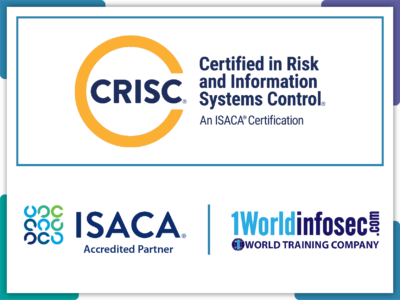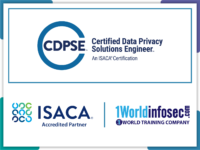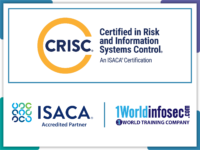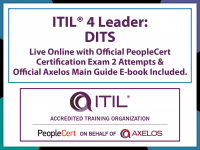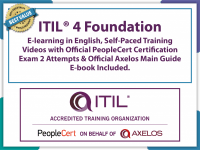Introduction to CRISC Certification
The Certified in Risk and Information Systems Control certification is a highly regarded credential that validates a professional’s skills in risk management and information systems. Established by ISACA, an internationally recognized organization dedicated to elevating the quality of information systems and governance, CRISC equips individuals with the knowledge and expertise necessary to manage IT risks effectively. Given the increasing importance of risk management in organizations, this certification is particularly significant for professionals aiming to enhance their career prospects in the field of information security.
ISACA’s mission is to provide professionals with the tools and knowledge needed to navigate the complexities of information systems. The CRISC certification aligns with this mission by focusing on key areas such as risk identification, assessment, response, and monitoring. By obtaining this certification, candidates demonstrate their ability to not only understand risk management frameworks but also to implement them, ensuring that organizations can meet their risk management objectives efficiently. Furthermore, this credential is recognized globally, making it a valuable asset for career advancement in diverse industries.
- The only globally accepted management-focused certification for professionals with three
or more years of experience in the management of IT risk and the design, implementation,
monitoring and maintenance of IS controls. - CRISC® certifications are for IT and business professionals, including risk and compliance
professionals, business analysts and project managers.
Individuals considering CRISC certification should be aware of the prerequisites involved. Candidates are typically expected to have a minimum of three years of work experience in at least two of the four CRISC domains, which include IT risk identification, assessment, response, and monitoring. The intended audience for this certification primarily includes risk professionals, IT managers, auditors, and compliance professionals aiming to deepen their understanding of risk management principles and practices. By pursuing CRISC, candidates position themselves as experts in risk management, enhancing their career trajectories while contributing positively to their organizations.
Understanding the CRISC Domains
The Certified in Risk and Information Systems Control (CRISC) certification, governed by ISACA, is an essential qualification for those looking to enhance their career in IT risk management. Within the CRISC framework, four key domains are integral to the examination and to the competencies candidates must develop: Risk Identification, Risk Assessment, Risk Response, and Risk Monitoring. Each of these domains encapsulates critical knowledge areas that equip professionals for effective risk management.
The first domain, Risk Identification, focuses on the necessity of recognizing potential risks that could impact the organization’s information systems and processes. Professionals must understand various types of risks, including IT-related risks, and be able to identify their sources. Mastery in this domain allows individuals to effectively map out the risk landscape of their organization.
Transitioning into the second domain, Risk Assessment emphasizes the importance of evaluating the identified risks in terms of their potential impact and likelihood. This includes understanding the qualitative and quantitative methods employed to assess risk severity. Professionals should be versed in assessing assets and their vulnerabilities to prioritize risks based on organizational objectives and risk tolerance levels.
In the third domain, Risk Response, candidates learn to develop strategic approaches to mitigate, transfer, accept, or avoid identified risks. This comprises not only formulating a response plan but also ensuring that the plan aligns with organizational policies and regulatory requirements. Skills in this area highlight a professional’s capability to address risks effectively before they materialize.
Finally, the fourth domain, Risk Monitoring, deals with the ongoing assessment of risk management strategies and processes. It involves setting indicators to monitor the effectiveness of the risk response and making necessary adjustments. The ability to continuously monitor risks ensures sustained resilience and preparedness against evolving threats, which is vital in today’s dynamic risk environment.
CRISC Certification Training Options
The CRISC (Certified in Risk and Information Systems Control) certification is pivotal for professionals aiming to enhance their careers in risk management and information systems. As such, selecting an appropriate training option is crucial for effective exam preparation. There are several modalities available, each catering to different learning preferences and circumstances.
Traditional classroom training provides an interactive environment where participants can engage directly with instructors and peers. This format often facilitates immediate feedback and discussion, making it effective for those who thrive on direct interaction. However, it typically involves fixed schedules, which can present challenges for individuals balancing work and personal commitments.
In contrast, online courses offer greater flexibility, allowing candidates to learn at their own pace and schedule. Many reputable organizations provide comprehensive online CRISC certification training, often featuring recorded lectures, interactive quizzes, and real-time discussions. This self-paced approach can be particularly appealing for professionals looking to integrate study into their busy lives. However, the lack of structured timelines may necessitate a high level of self-discipline from learners.
Self-study resources, including textbooks and online materials, are another option for CRISC candidates. This method allows for personalized study plans tailored to individual strengths and weaknesses. While it can be cost-effective, relying solely on self-study may leave some gaps in knowledge if not complemented by practice exams or other resources.
Boot camps present a concentrated approach with immersive training sessions. Typically lasting a few days, these intensive programs focus on key topics within a short timeframe. While often more expensive, boot camps can be highly effective for learners who prefer focused, high-impact learning experiences. Candidates should also consider reputable training providers, extensively reviewing ratings and feedback to ensure they choose programs that will adequately prepare them for this certification exam.
Preparing for the CRISC Exam
Effective preparation for this exam is paramount for candidates seeking to achieve certification and enhance their careers in risk management. A strategic approach to studying can greatly influence the outcomes of prospective test-takers. First and foremost, crafting a detailed study schedule should be a top priority. This schedule should allocate specific times for each topic, allowing ample time for both understanding the material and review.
Incorporating practice exams into your study regimen is another essential strategy. Practice tests not only familiarize candidates with the exam format but also help identify areas that may require additional focus. Numerous resources, such as ISACA’s official question banks, provide high-quality practice materials designed to closely mimic the actual exam. By regularly engaging with these materials, candidates can track their progress and build confidence.
Joining a study group can also be beneficial for candidates preparing for this exam. Collaborating with peers allows for the sharing of insights, different approaches to studying, and resources, thereby enriching the learning experience. Similarly, actively participating in forums or discussions related to CRISC can further enhance understanding and motivation.
Additionally, accessing ISACA’s official resources, including their study guides and webinars, can provide invaluable insights into key topics and recent updates in the exam framework. Understanding the format of the exam, which includes multiple-choice questions focusing on risk identification, assessment, and response, is critical for targeted preparation.
Lastly, managing exam-day anxiety is crucial as well. Candidates should practice relaxation techniques, such as deep breathing exercises or visualization, to maintain composure on the day of the exam. Adequate preparation combined with these strategies will significantly enhance candidates’ chances of success in obtaining the CRISC certification.
Career Impact of CRISC Certification
The Certified in Risk and Information Systems Control certification, offered by ISACA, serves as a pivotal credential for professionals navigating the increasingly complex landscape of risk management. For individuals aspiring to enhance their careers in this domain, obtaining the CRISC certification offers significant advantages that are both immediate and long-term. First and foremost, CRISC holders are recognized as experts in identifying and managing risks associated with information systems, which positions them favorably for advanced roles in risk management.
Employers across various industries seek professionals who not only understand risk management principles but can also apply them strategically to safeguard organizational interests. This heightened demand often translates into improved salary prospects for CRISC-certified professionals. Data indicates that individuals holding this credential can command salaries significantly above those without such qualifications, reflecting the value placed on expertise in mitigating risks and enhancing operational resilience.
Furthermore, CRISC certification opens doors to diverse job opportunities, ranging from risk analysts to senior risk management positions. Industries that heavily rely on information systems, such as finance, healthcare, and information technology, particularly value candidates with advanced risk management capabilities. As organizations increasingly integrate cybersecurity measures into their overall risk management strategies, certified professionals find themselves in highly sought-after roles.
In addition to tangible financial and professional benefits, obtaining CRISC also emphasizes the importance of continuous education. Professionals are encouraged to engage in ongoing coursework and network with fellow CRISC holders, fostering growth and sharing best practices in risk management. Ultimately, with a CRISC certification, professionals not only enhance their career trajectories but also contribute to strengthening the security framework of their organizations, thereby ensuring a safer and more resilient operational environment.
Key Areas: Deployment and management of enterprise IT risk and controls
Career Stage: Mid-level IT professionals looking for career growth in IT risk
Average Salary Data in US$* :US$167,145
Typical Job Titles for Certification Holders:
- Risk and Security Manager
- IS or Business Analyst
- IS Manager
- Operations Manager
- Information Control Manager
- Chief Information Security or Compliance Officer
Experience Required? One to three years of experience in IT risk and/or security and audit
Exam Required? Yes
Recommended Pre-Requisition: Early career candidates IT Risk Fundamentals certificate
CISA certification is a plus before starting
Hands-On Labs Included? No Knowledge-based exam
Recommended for Career Path Advancement? CISM and/or CGEIT to round out the knowledge and develop a more strategic mindset

